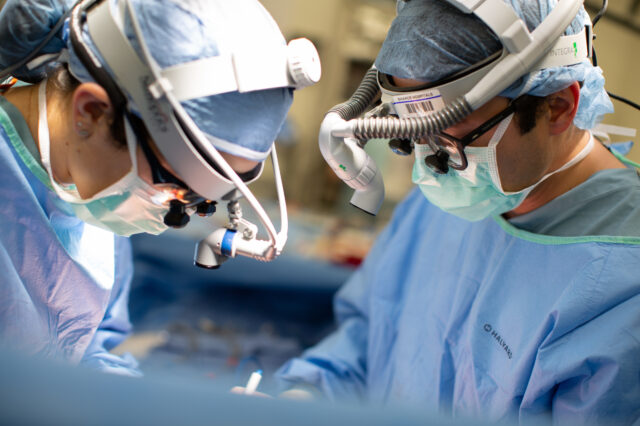UF Health lung transplant program outcomes nation’s best

The UF Health Shands Hospital lung transplant program tops the list as the best in the United States for one-year risk-adjusted survival rates, according to the Scientific Registry of Transplant Recipients, SRTR.
SRTR annually evaluates transplant programs around the country for metrics whose importance to transplant candidates are intuitive: how many reach the one-year post-transplant survival mark, how quickly you can get a transplant and survival rates on the wait list.
In SRTR’s January 2021 year report, UF Health Shands Hospital’s lung transplant program’s outcomes exceeded its previous years in each category, making it the top-tier program across the Southeast.
“We’re seeing incredible survival rates with high volume, high complexity cases, and minimal waitlist mortality,” said Tiago Machuca, M.D., Ph.D., chief of the division of thoracic surgery and surgical director of the lung transplant program.

As of January, the program’s one-year postoperative survival rate is 98%, almost 10% higher than the national average. Similarly, the waitlist mortality rate is 4%, versus the national average of 18%, and boasts an average of 1.2 months of time to transplant.
Simply put, the data collected indicate choosing UF Health for your lung transplant gives you a better overall outcome: a shorter wait time, the highest likelihood of surviving after transplant and the lowest likelihood of dying while waiting for new lungs.
“At our hospital, everything is driven by our commitment to the patient,” said UF Health Shands CEO Ed Jimenez. “Our lung transplant program is driven by a hope that we can change lives, longterm, for the better. These outcomes are just one reflection of that.”
SRTR, the most comprehensive database of solid organ transplant outcomes, provides quality oversight for solid organ transplantation. Data in the SRTR database are largely collected directly by the Organ Procurement and Transplantation Network, or OPTN, and are used by patients and health professionals alike to decide where to go — or refer someone — for a transplant.
For lung programs, the primary category measured by SRTR is the first-year organ survival, followed by getting a transplant faster and survival on the waitlist.
Since 1994, UF Health’s lung transplant program has performed more than 900 lung transplants, with an emphasis on cases that most would have deemed too difficult to transplant due to age, stature, comorbidities or advanced illness.
“Our patient population requires ongoing and attentive care before, during and after transplant,” said Andres Pelaez, M.D., medical director of the lung transplant program and an associate professor of medicine in the UF College of Medicine. “Not only does it demand a lot from our medical and surgical team, but also from the patient and their loved ones.”
Pelaez and his team are continually moved by the strength of the transplant patients they treat, citing their tenacity and resilience as some of the many reasons they push forward in their work. The team’s success stems from its interdisciplinary nature, which includes a dedicated thoracic ICU, pulmonologists, anesthesiologists and physical therapists, as well as ECMO specialists for the most advanced of cases — like COVID-related lung damage.
“Our patients span everything from chronic advanced lung disease, which impacts your quality of life and makes day-to-day activities more arduous, to those in the ICU, fighting for their life,” Machuca said. Machuca, who said he came to UF in 2015 in part because the university shared his commitment to growth. Since his team came together, the results speak for themselves.
“If you see where we were six years ago, the steep rise in quality is incredible,” Machuca said. “A growing number of patients have benefited as we increase access to lung transplantation, and parallel to that, we improve our outcomes.”
And although the outcomes speak to the program’s quality, they also reflect Machuca’s favorite sight: His patients going home.
“Seeing them get their lives back: walking out of the hospital, going to their kids’ graduations, their grandkids’ graduations, or going to college themselves,” Machuca said. “This is what brings us purpose — and what drives my whole team.”
Media contact: Ken Garcia at kdgarcia@ufl.edu or 352-273-9799.